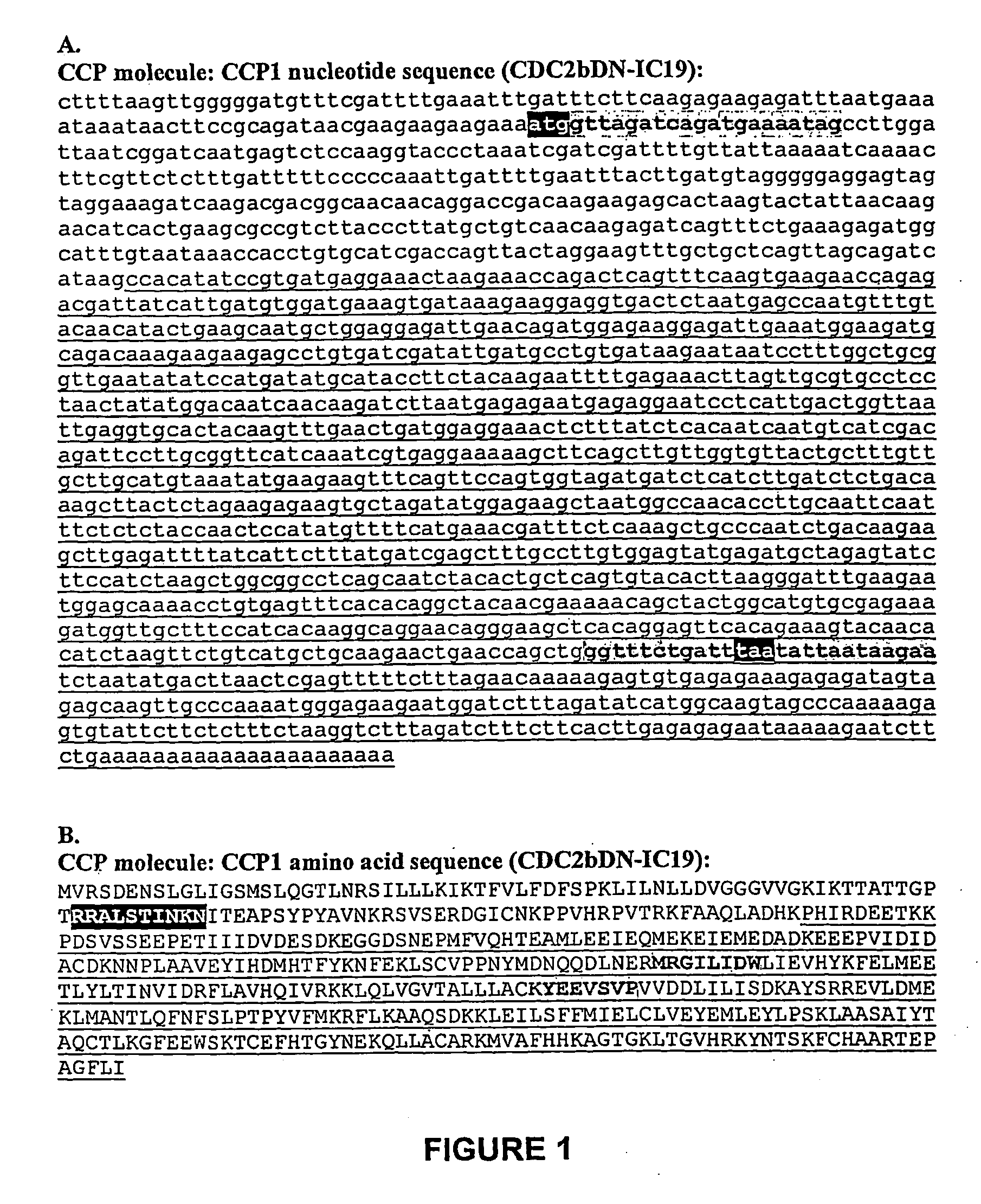Nucleic Acid Molecules Encoding Plant Cell Cycle Proteins and Uses Therefor
a technology of plant cell cycle and nucleic acid, which is applied in the field of nucleic acid molecules encoding plant cell cycle proteins and uses therefor, can solve the problems of largely plant developmen
- Summary
- Abstract
- Description
- Claims
- Application Information
AI Technical Summary
Benefits of technology
Problems solved by technology
Method used
Image
Examples
example 1
Identification of Plant Ccp Polypeptides Using the Two Hybrid System with CDC2B as a Bait
[0309]A two-hybrid screening was performed using as bait a fusion between the GAL4 DNA-binding domain and one of the following: CDC2bAt.N161 (GenBank accession number D10851; residue Asp161 converted into Asn161); CKS1At (GenBank accession number AJ00016); E2Fa (=E2F5) (GenBank accession number AJ294534) dimerization domain (226-356aa; SEQ ID NO:205); CKI4 (SEQ ID NO:264); PLP1 (GenBank accession number T01601); KLPNT1 (GenBank accession number AB011479; protein ID number BAB11568) motor domain (36-508 aa); KLPNT1 (GenBank accession number AB011479; protein ID number BAB11568) stalk domain (427-867 aa); KLPNT2=TH65 (GenBank accession number AJ001729) neck domain (3-186 aa); KLPNT2=TH65 (GenBank accession number AJ001729) stalk domain (73-608 aa); E2Fb (=E2F3) (GenBank accession number AJ294533) N-terminal domain (1-385 aa; SEQ ID NO:206), respectively
[0310]CDC2bAt.N161 is a dominant negative for...
example 2
Extension of CCP Encoding polynucleotides To Full Length or to Recover Regulatory Elements
[0316]The CCP encoding nucleic acid sequences (SEQ ID NO:1-66 or 228-239) are used to design oligonucleotide primers for extending a partial nucleotide sequence to full length or for obtaining 5′ sequences from genomic or cDNA libraries. One primer is synthesized to initiate extension in the antisense direction (XLR) and the other is synthesized to extend sequence in the sense direction (XLF). Primers allow the extension of the known CCP encoding sequence “outward” generating amplicons containing new, unknown nucleotide sequence for the region of interest. The initial primers are designed from the cDNA using OLIGO® 4.06 Primer Analysis Softvare (National Biosciences), or another appropriate program, to be preferably 22-30 nucleotides in length, to have a GC content of preferably 50% or more, and to anneal to the target sequence at temperatures preferably about 68°-72° C. Any stretch of nucleoti...
example 3
Expression of Recombinant Ccp Proteins in Transgenic Plants
[0322]In this example, the CCP molecules of the present invention were expressed in a 35S expression vector in transgenic plants. The CCP molecules of this invention were cloned using standard cloning procedures between a suitable promoter, e.g. the CaMV35S promoter or any promoter from e.g. Table II, and a suitable terminator, e.g., the NOS 3′ untranslated region. The resulting recombinant gene is subsequently cloned in a suitable binary vector and the resulting plant transformation vector is then transferred to Agrobacterium tumefaciens. Arabidopsis thaliana is transformed with this Agrobacterium applying the in planta flower-dip transformation method (Clough and Bent, Plant J. 16:735-743, 1998). Transgenic plant lines are selected on a growth medium containing the suitable selection agent (e.g., kanamycin or Basta) or on the basis of scoring the expression of a screenable marker (e.g., luciferase, green fluorescent protei...
PUM
| Property | Measurement | Unit |
|---|---|---|
| nucleic acid | aaaaa | aaaaa |
| concentration | aaaaa | aaaaa |
| CCP nucleic acid expression | aaaaa | aaaaa |
Abstract
Description
Claims
Application Information
 Login to View More
Login to View More - R&D
- Intellectual Property
- Life Sciences
- Materials
- Tech Scout
- Unparalleled Data Quality
- Higher Quality Content
- 60% Fewer Hallucinations
Browse by: Latest US Patents, China's latest patents, Technical Efficacy Thesaurus, Application Domain, Technology Topic, Popular Technical Reports.
© 2025 PatSnap. All rights reserved.Legal|Privacy policy|Modern Slavery Act Transparency Statement|Sitemap|About US| Contact US: help@patsnap.com



